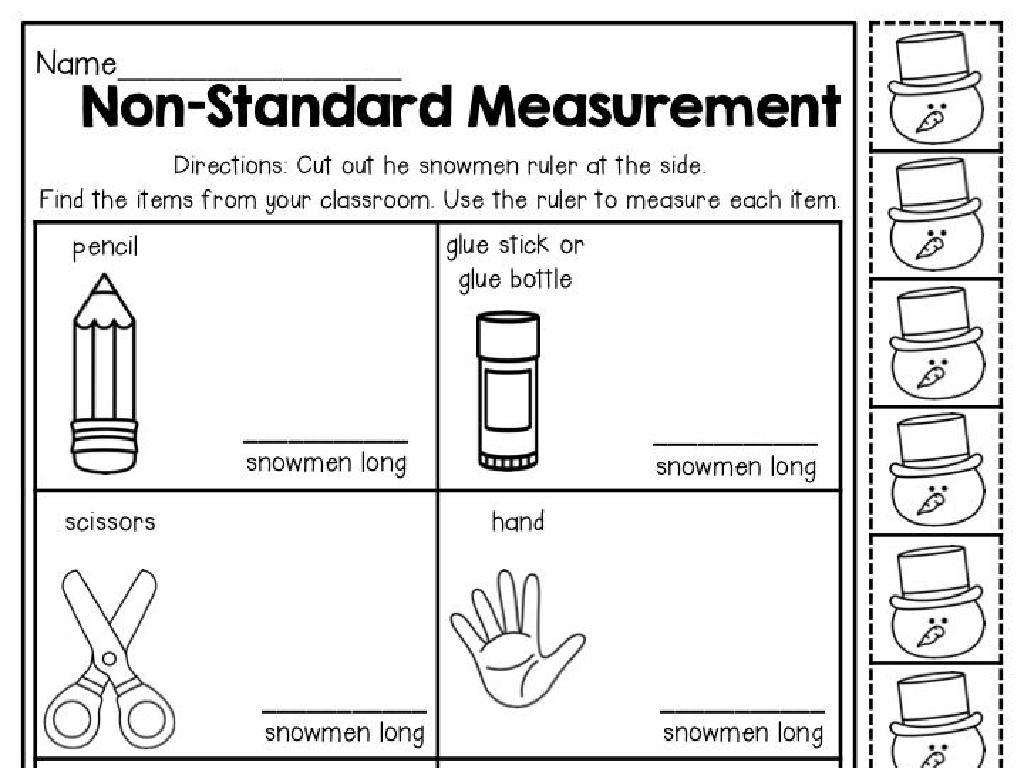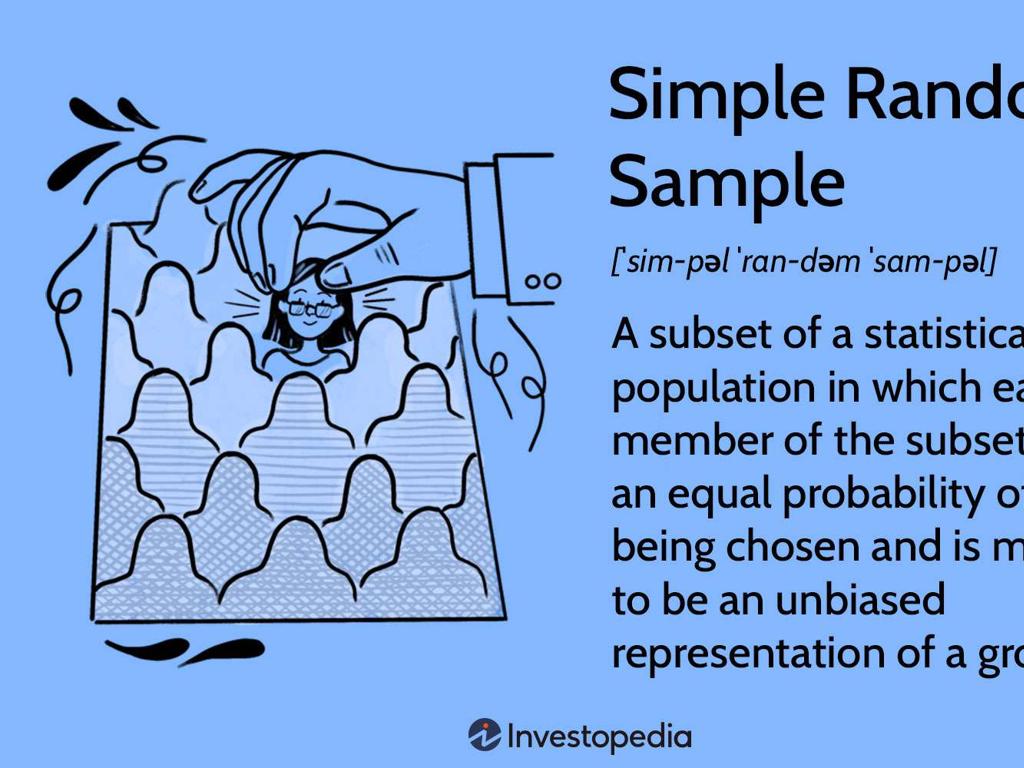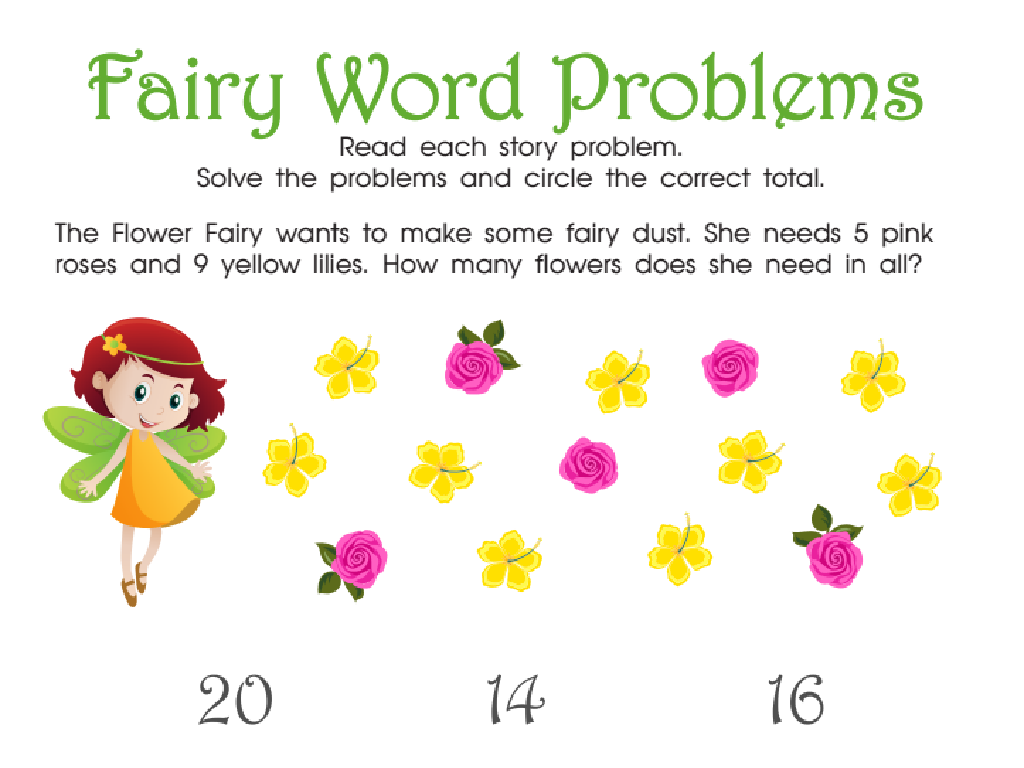Put A Mix Of Decimals, Fractions, And Mixed Numbers In Order
Subject: Math
Grade: Sixth grade
Topic: Fractions And Decimals
Please LOG IN to download the presentation. Access is available to registered users only.
View More Content
Ordering Fractions, Decimals, and Mixed Numbers
– Understanding fractions and decimals
– Fractions represent parts of a whole; decimals are another form of fractions
– Daily applications of these numbers
– Used in money, measurements, and time
– Why number order is crucial
– Ordering helps in fair sharing, timing events, and budgeting
– Strategies to compare and order
– Convert to decimals or use benchmarks like 0, 1/2, and 1 to compare
|
This slide introduces the concept of fractions and decimals, aiming to show their relevance in everyday life and the importance of understanding how to put them in order. Emphasize that fractions and decimals are just different ways to represent the same concept: parts of a whole. Illustrate with examples such as money (cents as decimals, dollars as mixed numbers), measurements (inches on a ruler), and time (minutes as fractions of an hour). Highlight that being able to order these numbers is essential for practical tasks like budgeting money or measuring ingredients in cooking. Teach strategies for ordering, such as converting all numbers to decimals or using common benchmarks. Encourage students to practice these skills with real-life examples.
Review of Fractions: Understanding the Basics
– Definition of a fraction
– A fraction represents a part of a whole
– Numerator vs. Denominator
– Top number (numerator) and bottom number (denominator)
– Fractions in daily life
– Pizza slices, measuring cups, and money (quarters)
– Comparing fractions
– Use common denominators or convert to decimals
|
This slide aims to refresh students’ understanding of fractions before delving into ordering a mix of decimals, fractions, and mixed numbers. Begin by defining a fraction and its components: the numerator, which indicates the number of parts, and the denominator, which shows the total number of equal parts in the whole. Provide relatable examples such as slices of pizza to represent fractions of a whole item, or using measuring cups in cooking to demonstrate fractions in quantities. Emphasize the importance of understanding fractions to compare them effectively, which is a skill they will need for ordering different numerical representations. Encourage students to think of other examples from their daily lives where they encounter fractions.
Review of Decimals: Ordering Numbers
– Define a decimal
– A decimal represents a part of a whole number
– Place value importance
– Each place after the decimal means tenths, hundredths, etc.
– Decimals in daily life
– Money uses decimals: $0.25, $1.50, $3.75
– Comparing decimals
– Arrange decimals by looking at the highest place value first
|
This slide is aimed at reviewing the concept of decimals, which is crucial for understanding how to order a mix of numbers. Start by defining a decimal and its role in representing fractions. Emphasize the importance of place value, as it determines the size of the number. Provide relatable examples, such as money, to illustrate decimals in everyday life. Finally, guide students through the process of comparing and ordering decimals by examining digits from left to right, starting with the highest place value. Encourage students to practice with real-life examples and to visualize decimals on a number line for better understanding.
Understanding Mixed Numbers
– Define a mixed number
– A number with a whole part and a fraction part, e.g., 2 3/4
– Convert to improper fractions
– Multiply whole number by denominator, add numerator, e.g., 2*4+3
– Real-world mixed number examples
– Examples: 1 1/2 liters of soda, 3 3/4 hours in a marathon
– Practice ordering mixed numbers
|
Begin with a clear definition of mixed numbers, ensuring students understand the two parts: the whole number and the fraction. Demonstrate the conversion process to improper fractions with step-by-step examples. Use relatable real-world scenarios where mixed numbers are commonly used, such as in cooking or time measurement, to illustrate their practical application. Finally, engage students with an activity to practice putting mixed numbers, along with decimals and fractions, in order to solidify their understanding. This will prepare them for more complex operations involving mixed numbers.
Comparing and Ordering Numbers
– Compare fractions, decimals, mixed numbers
– Use equivalent forms or common denominators to compare different types of numbers
– Use a number line for ordering
– Place numbers on a number line to visually compare their sizes
– Convert between forms for comparison
– Change fractions to decimals or vice versa to make comparison easier
– Practice with examples
|
This slide is aimed at teaching students how to compare and order different types of numbers, including fractions, decimals, and mixed numbers. Start by explaining the concept of equivalence and the importance of having a common denominator when comparing fractions. Introduce the number line as a tool to help visualize and understand the order of numbers. Demonstrate how to convert between fractions and decimals, and emphasize that this skill is crucial for comparing numbers that are in different forms. Provide practice examples for students to apply these concepts, such as ordering a set of mixed numbers and decimals on a number line. Encourage students to explain their reasoning during the practice to reinforce their understanding.
Ordering Decimals, Fractions, and Mixed Numbers
– Convert to common form
– Change fractions and mixed numbers to decimals or vice versa
– Arrange least to greatest
– Use number line or compare decimals directly
– Check with examples
– Use examples like money or measurements
– Practice problems
|
This slide is aimed at teaching students how to order a mix of decimals, fractions, and mixed numbers. Start by converting all numbers to a common form, such as decimals, to simplify comparison. Once converted, guide students to arrange the numbers from the smallest to the largest. Use real-world examples like different amounts of money or lengths of objects to demonstrate how this skill is used in everyday life. Finally, provide practice problems for students to apply what they’ve learned. Encourage students to explain their reasoning for the order they choose, reinforcing their understanding of the concept.
Ordering Decimals, Fractions, and Mixed Numbers
– Convert all numbers to a common format
– Change fractions to decimals or vice versa for uniformity
– Use number lines for visual comparison
– Place numbers on a line to see their order clearly
– Compare using equivalent fractions
– Find common denominators to compare sizes
– Practice with class examples
|
This slide is aimed at practicing the skill of ordering a mix of decimals, fractions, and mixed numbers. Start by demonstrating how to convert all numbers to either decimals or fractions to make comparison easier. Introduce the concept of a number line as a visual tool to help students understand the relative size of numbers. Discuss the importance of finding equivalent fractions with a common denominator to compare fractions effectively. Engage the class with hands-on examples and encourage participation by having students come to the board to solve problems. Provide a variety of problems and facilitate peer discussion to reinforce learning. The goal is for students to feel comfortable with these concepts and to apply them confidently in different scenarios.
Class Activity: Ordering Numbers Challenge
– Group activity introduction
– Distribute number cards to groups
– Collaborate to order numbers
– Work as a team to place decimals, fractions, and mixed numbers in sequence
– Discuss ordering strategies
– Consider using number lines or converting to similar forms for comparison
|
This activity is designed to encourage teamwork and critical thinking as students work together to order a mix of decimals, fractions, and mixed numbers. Provide each group with a set of number cards. Students should discuss and decide on the best strategy to order the numbers correctly. Possible strategies include converting all numbers to decimals or fractions for easier comparison, or using a number line to visualize the correct order. As they work, circulate around the room to offer guidance and ensure that each group is engaged and on task. After the activity, lead a class discussion on the different strategies used and what they learned about ordering different types of numbers.
Conclusion & Homework: Mastering Number Order
– Recap of ordering numbers
– Why ordering is crucial
Ordering helps in real-life situations like banking or cooking.
– Homework: Practice worksheet
Complete the worksheet to practice ordering fractions, decimals, and mixed numbers.
– Keep practicing at home!
|
Today’s lesson focused on the skills needed to put various forms of numbers in order. Understanding how to arrange decimals, fractions, and mixed numbers is essential for everyday math applications, such as comparing prices or measuring ingredients. For homework, students are assigned a worksheet that provides additional practice to reinforce these concepts. Encourage students to attempt the worksheet independently, and remind them that practice is key to mastery. The worksheet should include a variety of problems, some of which may be challenging, to help students prepare for more advanced math concepts.






